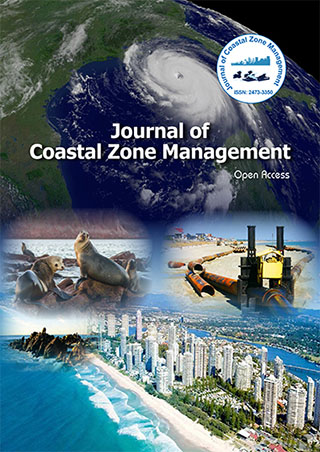Indexed In
- SafetyLit
- RefSeek
- Hamdard University
- EBSCO A-Z
- OCLC- WorldCat
- Publons
Useful Links
Share This Page
Journal Flyer

Open Access Journals
- Agri and Aquaculture
- Biochemistry
- Bioinformatics & Systems Biology
- Business & Management
- Chemistry
- Clinical Sciences
- Engineering
- Food & Nutrition
- General Science
- Genetics & Molecular Biology
- Immunology & Microbiology
- Medical Sciences
- Neuroscience & Psychology
- Nursing & Health Care
- Pharmaceutical Sciences
Perspective - (2022) Volume 25, Issue 10
Perspectives upon Integrated Coastal Zone Management
Yuang Xiao*Received: 04-Oct-2022, Manuscript No. JCZM-22-18655; Editor assigned: 06-Oct-2022, Pre QC No. JCZM-22-18655 (PQ); Reviewed: 21-Oct-2022, QC No. JCZM-22-18655; Revised: 31-Oct-2022, Manuscript No. JCZM-22-18655 (R); Published: 08-Nov-2022, DOI: 10.35248/2473-3350.22.25.529
Description
India's coastal zones are exceptional because they offer a variety of eco-resources to stakeholders at many levels, from local residents to the State and Central Governments. The end users take these varied resources as and when they are required. With a few exceptions, India lacks a comprehensive system for the preservation and management of these resources. The conservation of these distinctive plants and animals, as well as the land regions, therefore, calls for the identification and implementation of specific special strategies and policies. An essential tool for safeguarding all of these coastal resources is integrated coastal zone management, which makes it possible to develop comprehensive programmers that involve all end users.
Overall Coastal regions have a strong pull for habitation and the growth of economic activity because they can produce significant affluence for society. Ecosystem services are the term used frequently to describe the societal advantages of coastal areas. Because of the location at the meeting point of land and sea, natural and societal processes must interact in extremely dynamic ways with powerful positive and negative feedback loops. Additionally, this makes coastal areas susceptible, demanding careful management that takes into account the numerous interdependencies and short- and long-term trends.
The methods used to manage the coastal zone nowadays vary frequently. A disaster frequently occurs before structural, legal, or institutional changes are enacted. The methods used to manage the coastal zone nowadays vary frequently. A disaster frequently occurs before structural, legal, or institutional changes are enacted. These changes frequently don't have a thoughtful long-term plan and instead concentrate on solving the most immediate problems. By taking into account a variety of interests and potential futures, integrated coastal zone control aims to prevent (or lessen the impact of) disasters and promote the longterm sustainability of the coastal zone.
The concept "coastal zone" refers to the ecological surrounding areas of land and water, such as a tiny island or a watershed on a huge volcanic island. The term "management" refers to making the best use of the resources at hand to accomplish a task. Mangrove forests, coastal seas, and coral reefs are just a few examples of the "common property resources" that are the focus of Integrated Coastal Zone Management (ICZM).The sustainable quality of coastal ecosystems and coastal communities while embracing the human dimension were the ultimate goals of ICZM. Multi-sectorial planning, public participation, and conflict resolution are all made possible by a balance between development and conservation that involves both the government and local people. Small scale, and as colonization increased, control shifted from national and local governments to communities. Modern planning and resource management ideas, extensive information bases, and interdisciplinary processes are all incorporated within ICZM. It has shown to be a useful overall framework for resolving disputes brought about by interactions between different usages of coastal areas. It seeks to manage resources and develop in concert.
A large framework of governmental and interest group involvement is necessary for ICZM to succeed. Complex operations such as fishing, mining, shipping, defense, public health, and recreation necessitate collaborative management and intersectional coordination. The coordination demands the full participation of all relevant stakeholders through an integrated and comprehensive ICZM initiative.
From a geopolitical and strategic standpoint, it might be simpler to create a national programmer of the ICZM type if the control zone is limited as opposed to vast. Managing a small, largely tidally influenced transitional area may be easier to be approved for than a larger area that encompasses both higher and drier shore lands and deeper areas of the ocean. Coastal lowlands, intertidal zones, salt marshes, wetlands, beaches, and offshore features like coral reefs and island habitats should all be included in the zone at the very least.
The Integrated Coastal and Marine Area Management (ICMAM) programmer was established by the Ministry of Earth Sciences to encourage research on issues pertaining to coastal processes, ecosystems, shoreline erosion, pollution, hazards, and coastal protective factors. The marine resources have seen major change as a result of growing industrial expansion, commercial pressure, and opportunistic development, despite the ecological, economic, and sociocultural importance of coastal ecosystems. The destruction of significant biodiversity resource centers results from the construction of coastal infrastructure in violation of the law concerning environmental protection. The only method is integrated coastal zone management.
Citation: Xiao Y (2022) Perspectives upon Integrated Coastal Zone Management. J Coast Zone Manag. 25:529.
Copyright: © 2022 Xiao Y. This is an open-access article distributed under the terms of the Creative Commons Attribution License, which permits unrestricted use, distribution, and reproduction in any medium, provided the original author and source are credited.
